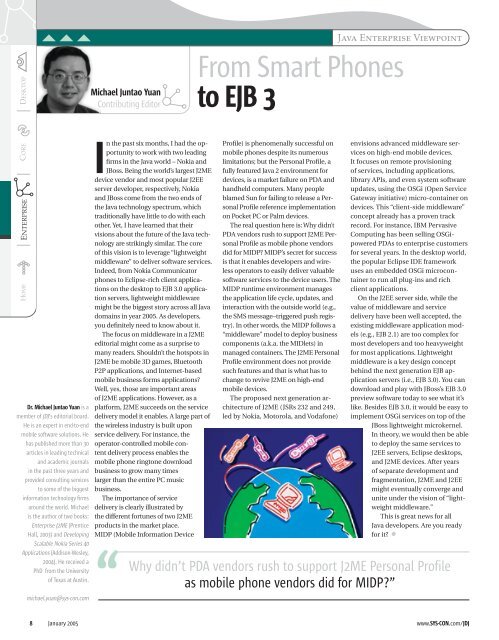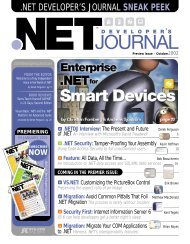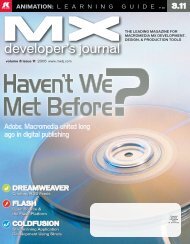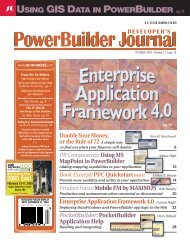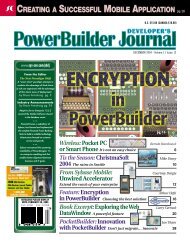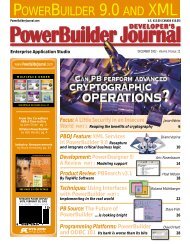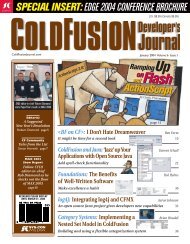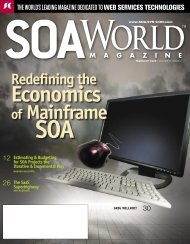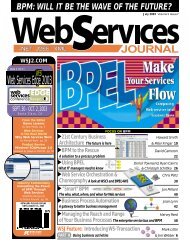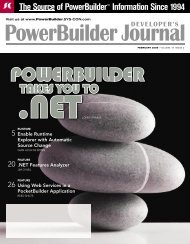JDJ 10-1.indd - sys-con.com's archive of magazines - SYS-CON Media
JDJ 10-1.indd - sys-con.com's archive of magazines - SYS-CON Media
JDJ 10-1.indd - sys-con.com's archive of magazines - SYS-CON Media
- No tags were found...
You also want an ePaper? Increase the reach of your titles
YUMPU automatically turns print PDFs into web optimized ePapers that Google loves.
Michael Juntao YuanContributing EditorJava Enterprise ViewpointFrom Smart Phonesto EJB 3Dr. Michael Juntao Yuan is amember <strong>of</strong> <strong>JDJ</strong>’s editorial board.He is an expert in end-to-endmobile s<strong>of</strong>tware solutions. Hehas published more than 30articles in leading technicaland academic journalsin the past three years andprovided <strong>con</strong>sulting servicesto some <strong>of</strong> the biggestinformation technology firmsaround the world. Michaelis the author <strong>of</strong> two books:Enterprise J2ME (PrenticeHall, 2003) and DevelopingScalable Nokia Series 40Applications (Addison-Wesley,2004). He received aPhD from the University<strong>of</strong> Texas at Austin.michael.yuan@<strong>sys</strong>-<strong>con</strong>.comIn the past six months, I had the opportunityto work with two leadingfirms in the Java world – Nokia andJBoss. Being the world’s largest J2MEdevice vendor and most popular J2EEserver developer, respectively, Nokiaand JBoss come from the two ends <strong>of</strong>the Java technology spectrum, whichtraditionally have little to do with eachother. Yet, I have learned that theirvisions about the future <strong>of</strong> the Java technologyare strikingly similar. The core<strong>of</strong> this vision is to leverage “lightweightmiddleware” to deliver s<strong>of</strong>tware services.Indeed, from Nokia Communicatorphones to Eclipse-rich client applicationson the desktop to EJB 3.0 applicationservers, lightweight middlewaremight be the biggest story across all Javadomains in year 2005. As developers,you definitely need to know about it.The focus on middleware in a J2MEeditorial might come as a surprise tomany readers. Shouldn’t the hotspots inJ2ME be mobile 3D games, BluetoothP2P applications, and Internet-basedmobile business forms applications?Well, yes, those are important areas<strong>of</strong> J2ME applications. However, as aplatform, J2ME succeeds on the servicedelivery model it enables. A large part <strong>of</strong>the wireless industry is built uponservice delivery. For instance, theoperator-<strong>con</strong>trolled mobile <strong>con</strong>tentdelivery process enables themobile phone ringtone downloadbusiness to grow many timeslarger than the entire PC musicbusiness.The importance <strong>of</strong> servicedelivery is clearly illustrated bythe different fortunes <strong>of</strong> two J2MEproducts in the market place.MIDP (Mobile Information Device“Pr<strong>of</strong>ile) is phenomenally successful onmobile phones despite its numerouslimitations; but the Personal Pr<strong>of</strong>ile, afully featured Java 2 environment fordevices, is a market failure on PDA andhandheld computers. Many peopleblamed Sun for failing to release a PersonalPr<strong>of</strong>ile reference implementationon Pocket PC or Palm devices.The real question here is: Why didn’tPDA vendors rush to support J2ME PersonalPr<strong>of</strong>ile as mobile phone vendorsdid for MIDP? MIDP’s secret for successis that it enables developers and wirelessoperators to easily deliver valuables<strong>of</strong>tware services to the device users. TheMIDP runtime environment managesthe application life cycle, updates, andinteraction with the outside world (e.g.,the SMS message–triggered push registry).In other words, the MIDP follows a“middleware” model to deploy businesscomponents (a.k.a. the MIDlets) inmanaged <strong>con</strong>tainers. The J2ME PersonalPr<strong>of</strong>ile environment does not providesuch features and that is what has tochange to revive J2ME on high-endmobile devices.The proposed next generation architecture<strong>of</strong> J2ME (JSRs 232 and 249,led by Nokia, Motorola, and Vodafone)envisions advanced middleware serviceson high-end mobile devices.It focuses on remote provisioning<strong>of</strong> services, including applications,library APIs, and even <strong>sys</strong>tem s<strong>of</strong>twareupdates, using the OSGi (Open ServiceGateway initiative) micro-<strong>con</strong>tainer ondevices. This “client-side middleware”<strong>con</strong>cept already has a proven trackrecord. For instance, IBM PervasiveComputing has been selling OSGipoweredPDAs to enterprise customersfor several years. In the desktop world,the popular Eclipse IDE frameworkuses an embedded OSGi micro<strong>con</strong>tainerto run all plug-ins and richclient applications.On the J2EE server side, while thevalue <strong>of</strong> middleware and servicedelivery have been well accepted, theexisting middleware application models(e.g., EJB 2.1) are too complex formost developers and too heavyweightfor most applications. Lightweightmiddleware is a key design <strong>con</strong>ceptbehind the next generation EJB applicationservers (i.e., EJB 3.0). You candownload and play with JBoss’s EJB 3.0preview s<strong>of</strong>tware today to see what it’slike. Besides EJB 3.0, it would be easy toimplement OSGi services on top <strong>of</strong> theJBoss lightweight microkernel.In theory, we would then be ableto deploy the same services toJ2EE servers, Eclipse desktops,and J2ME devices. After years<strong>of</strong> separate development andfragmentation, J2ME and J2EEmight eventually <strong>con</strong>verge andunite under the vision <strong>of</strong> “lightweightmiddleware.”This is great news for allJava developers. Are you readyfor it?Why didn’t PDA vendors rush to support J2ME Personal Pr<strong>of</strong>ileas mobile phone vendors did for MIDP?”8 January 2005www.<strong>SYS</strong>-<strong>CON</strong>.com/<strong>JDJ</strong>


